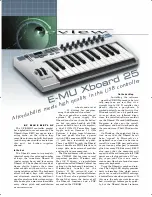
Preface
Disk Care
vii
Care and Feeding of the Disk Drive
The ASR-10’s built-in disk drive is used to store all your Instruments, Banks, and Sequencer data,
as well as System Exclusive messages from other MIDI devices. The ASR-10 uses a Quad-density
disk drive that can store 1600 Kilobytes of data on a Double-Sided High-Density (DSHD) 3.5”
micro-floppy disk and 800 Kilobytes of data on a Double-Sided Double-Density (DSDD) 3.5”
micro-floppy disk. The disks are enclosed in a protective plastic carrier with an automatic shutter
to protect the diskette from physical damage. It is important not to alter this carrier in any way.
The 3.5” disks have a sliding write-
protection tab so that you can protect
your sounds and sequences against
accidental erasure. Sliding the write-
protection tab in the lower left corner of
the disk so that the window is closed
will allow you to store information on
the disk. Sliding the tab so that the
window is open will protect the disk
against being accidentally reformatted
or having files deleted. Double-Sided
High Density disks can be easily
identified because they have an
additional window (with no write-
protection tab) located on the lower
right corner of the disk.
Double-Sided High-Density (DSHD)
Double-Sided Double-Density (DSDD)
Write Protect Tab
Write Protect Tab
No Disk
Window
Disk
Window
Floppy disks are a magnetic storage medium, and should be treated with the same care you’d
give important audio tapes. Just as you would use high quality audio tapes for your important
recording needs, we recommend using high quality floppy disks for your ASR-10. Here are a few
Do’s and Don’t’s concerning disks and the disk drive.
Do’s:
• Use either Double-Sided High-Density (DSHD) or Double-Sided Double-Density (DSDD) 3.5
inch Micro-floppy disks. Both types are available from almost any computer store and many
music stores carry them as well.
• Keep your disks and the disk drive clean and free of dust, dirt, liquids, etc.
• Label your disks and keep a record of what is saved on each.
• Only transport your unit with nothing in the drive.
Don’t’s:
• Don’t use Single-Sided (SSDD or SSSD) disks. These disks have not passed testing on both
sides. While a single-sided disk might work successfully with the ASR-10, it is possible that
you will eventually lose important data to a disk error if you try using Single-Sided disks.
• Don’t put anything other than a disk or the plastic sheet in the disk drive.
• Don’t transport the unit with a disk in the drive.
• Don’t expose disks to extremes of temperature. Temperatures below 50˚ F and above 140˚ F
can damage the plastic outer shell.
• Don’t expose your disks to moisture.
• Don’t dry your disks in a microwave oven.
• Don’t subject disks to strong magnetic fields. Exposure to magnetic energy can permanently
damage the information on the disk. Keep disks away from speaker cabinets, tape decks,
power cables, airline x-ray equipment, power amplifiers, TV sets, and any other sources of
magnetic energy.
• Don’t eject the disk while the drive is operating (i.e. when the disk drive light is on).









































